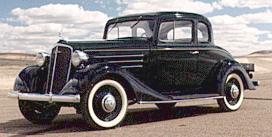Hi Jim,
I know this is an obvious question, but did you try claying a second time? I know that I don't always get 100% of the overspray off with one claying procedure. I recently clayed a car, then went over the car with scratchX and then just for fun I clayed it again and I still removed gunk from the finish that the first claying process didn't remove and the ScratchX didn't remove.
After that, sanding with the Abralon system is a fairly safe way to go as long as you stay away from high points, edges and any place you cannot machine buff with your rotary to remove your sanding marks.
Another option that I used to remove the white over spray off of a black 1934 Chevrolet Coupe was to rub the entire finish down using some #4 Heavy Cut Cleaner and a piece of terry cloth towel, and then come back and remove my rubbing marks with a W-8006 foam polishing pad on the rotary buffer with some #2 Fine Cut Cleaner.
Here's what the car looked like, (Note: This is not the car I worked on, just what the car looked like).
It had a lot of edges and raised body lines, as well as hard to reach with a buffer areas, so I couldn't buff it aggressively by machine.
This was before the 80's series, and before clay was introduced to America. My process worked however, it just took a long time as I had to be very careful not to rub through the paint. The #4 Heavy Cut Cleaner has a very aggressive diminishing abrasive in it that is easily felt between your fingers. It was this diminishing abrasive and the terry cloth that provided enough
bite to both abrade, and loosen the hold of the over spray from the finish.
Another option would be to lightly buff the paint with a wool pad and either a compound or a cleaner/polish. Foam pads tend to glide over overspray and polish the overspray to a high gloss because foam pads tend to be on the gentle side as compared to wool pads. The wool fibers that make up a wool pad are better at cutting into the finish and will tend to be better at removing little dots of paint by kicking them off versus gliding over them.
If it were me, I would first try multiple clay passes to play it safe. If you've already done this and overspray still exists, this tells you that the paint/solvent/carrying agent is of a type that was able to chemically bond to the Lincolns finish probably by melting/etching into the clear coat. If this is the case, it may be very difficult to remove safely, let alone completely or quickly.
I'm always telling people at our Saturday classes that sometimes you are better off to
improve a defect, than to try to completely
remove a defect with the understanding that you only have so much film-build to safely work with.
Meguiar's always teaches people to first, "Evaluate the Surface".
I always teach people to first, "Evaluate the Customer".
There are some customers that I don't want to work for because I know I can never meet their expectations. I'm not saying this is the case with this company, but it could be that this overspray problem is one of those problems that nobody, or no companies product can
completely fix. If this is the case, then you always want to be upfront and honest with the customer, explain t them to the best of you ability what the problem is, what you can do and then let them decide. Better to play it safe then to make a mistake and have to pay for it twice. Once with your wallet, and a second time with your reputation.
Hope this helps...
Mike

